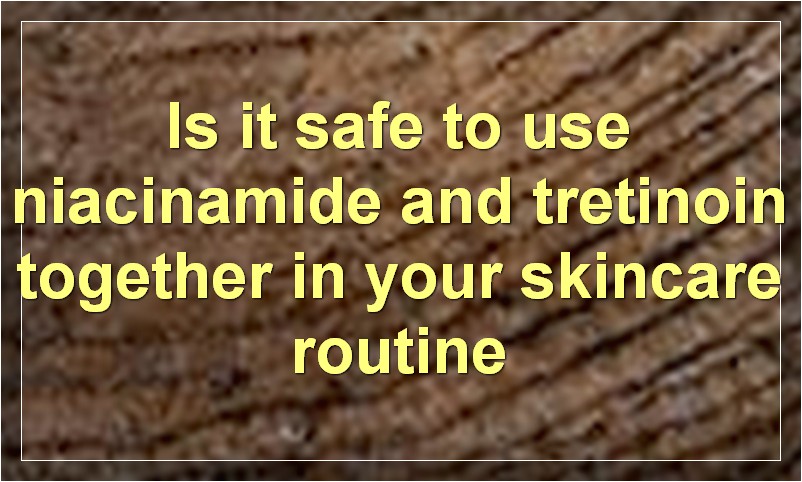Niacinamide and tretinoin are two of the most effective skincare ingredients out there. Here’s how to use them to get the best results.
What are the benefits of using niacinamide and tretinoin in your skincare routine?
When it comes to taking care of your skin, there are a lot of products on the market that claim to be the best. However, two ingredients that you may not have heard of are niacinamide and tretinoin. Here’s a look at what these two ingredients can do for your skin and why you should consider adding them to your skincare routine.
Niacinamide is a form of vitamin B3 that is often used in skincare products. It is known for its ability to brighten skin and even out skin tone. Niacinamide can also help to reduce the appearance of fine lines and wrinkles, as well as improve the elasticity of the skin. In addition, niacinamide is an effective ingredient for treating acne.
Tretinoin is a retinoid that is derived from vitamin A. Retinoids are known for their ability to improve the appearance of wrinkles and fine lines. Tretinoin can also help to even out skin tone and improve the texture of the skin. In addition, tretinoin can help to reduce the size of pores and increase collagen production.
There are a number of benefits to using niacinamide and tretinoin in your skincare routine. These two ingredients can help to improve the overall appearance of your skin and make you look younger. If you are looking for a way to take care of your skin, then consider adding niacinamide and tretinoin to your skincare routine.
What are the best ways to use niacinamide and tretinoin for optimal results?

Niacinamide and tretinoin are two of the most popular active ingredients in skincare products today. They’re both lauded for their ability to improve the look of skin, but how do you use them for optimal results?
Here’s a breakdown of niacinamide and tretinoin, including how to use them and what to expect from each one.
What is niacinamide?
Niacinamide is a form of vitamin B3 that’s water-soluble and often used in skincare products. It’s a multitasker that offers a variety of benefits, such as:
reducing the appearance of fine lines and wrinkles
fading dark spots
minimizing pores
improving skin texture
How do you use niacinamide?
You can find niacinamide in a variety of formulations, including serums, creams, and even moisturizers. It’s important to start slowly when incorporating a new product with niacinamide into your routine. Use it every other day, gradually increasing to daily use.
If you have sensitive skin, you may want to consider using a product with a lower concentration of niacinamide (2-5%). For best results, apply niacinamide to clean, dry skin before your moisturizer.
What is tretinoin?
Tretinoin is a prescription retinoid that’s derived from vitamin A. It’s available in multiple strengths, ranging from 0.025% to 0.1%. Tretinoin works by increasing cell turnover and accelerating the growth of new skin cells. This helps improve the look of fine lines, wrinkles, and pigmentation.
Tretinoin can be drying, so it’s important to start slowly and increase usage gradually. Begin by using the product every other day, then increase to nightly usage as tolerated. If your skin becomes too dry or irritated, cut back to using the product every third night. Be sure to apply tretinoin to clean, dry skin before your moisturizer.
Which one should you use?
If you’re trying to decide between niacinamide and tretinoin, there are a few things to consider. First, think about your goals. Niacinamide is best for those looking for general improvement in the appearance of their skin. Tretinoin is better suited for those targeting specific concerns like fine lines, wrinkles, or pigmentation.
It’s also important to consider your skin type. If you have sensitive skin, niacinamide may be a better option since it’s less likely to cause irritation. Those with oily skin may benefit from tretinoin since it can help reduce sebum production.
How often should you use niacinamide and tretinoin in your skincare routine?
Niacinamide is a form of vitamin B3 that’s often used in skincare products. Tretinoin is a retinoid, which is a type of vitamin A. Both niacinamide and tretinoin can be beneficial for your skin.
Niacinamide can help improve the appearance of skin texture, fine lines, and dullness. Tretinoin can help with acne, fine lines, and wrinkles.
So, how often should you use niacinamide and tretinoin in your skincare routine? It depends on your individual skin needs. If you’re using niacinamide to help with the appearance of skin texture, you can use it once or twice a day. If you’re using tretinoin for acne, you may need to use it every day or every other day.
Talk to your dermatologist about how often you should use niacinamide and tretinoin in your skincare routine to get the best results for your skin.
What are some common side effects of using niacinamide and tretinoin in your skincare routine?
Niacinamide and tretinoin are two of the most popular skincare ingredients on the market today. They’re both known for their ability to improve the look of skin, but they can also cause some side effects.
The most common side effect of niacinamide is mild irritation, which typically goes away after a few days of use. Tretinoin can also cause irritation, redness, and dryness. These side effects are usually temporary and will go away with continued use.
If you experience any severe side effects, stop using the product and consult a doctor.
What are some tips for using niacinamide and tretinoin in your skincare routine?
When it comes to getting the most out of your skincare routine, using niacinamide and tretinoin can be a great way to improve your skin’s overall appearance. Here are some tips on how to use these two ingredients in your skincare routine:
1. Use them together: Niacinamide and tretinoin work well together to help improve the overall appearance of your skin. When used together, they can help to brighten your skin tone, improve texture, and reduce the appearance of fine lines and wrinkles.
2. Use them in different products: You can also use niacinamide and tretinoin in different products throughout your skincare routine. For example, you could use a niacinamide serum in the morning followed by a tretinoin cream at night.
3. Be consistent: Like with any other skincare ingredient, consistency is key when using niacinamide and tretinoin. Be sure to use them every day as directed in order to see the best results.
4. Talk to your doctor: If you have any questions or concerns about using niacinamide or tretinoin in your skincare routine, be sure to talk to your doctor or dermatologist first. They can help you determine if these ingredients are right for you and how to best use them.
Is it safe to use niacinamide and tretinoin together in your skincare routine?

Niacinamide and tretinoin are two of the most popular ingredients in skincare products today. They are both known for their ability to improve the appearance of skin, but they are also known for their potential side effects.
So, is it safe to use niacinamide and tretinoin together?
The short answer is yes, it is safe to use niacinamide and tretinoin together. However, there are a few things you should know before using these two ingredients together.
Niacinamide is a form of vitamin B3 that is often used in skincare products for its ability to improve the appearance of skin. Niacinamide can help to brighten the skin, even out skin tone, and reduce the appearance of fine lines and wrinkles.
Tretinoin is a form of vitamin A that is often used in skincare products for its ability to improve the appearance of skin. Tretinoin can help to reduce the appearance of fine lines and wrinkles, improve skin texture, and promote cell turnover.
While both niacinamide and tretinoin are considered safe for most people to use, there are some potential side effects that you should be aware of. The most common side effect associated with niacinamide is mild irritation, while the most common side effect associated with tretinoin is increased sensitivity to sunlight.
If you are concerned about potential side effects, you may want to talk to your doctor or dermatologist before using niacinamide and tretinoin together.
What are some other products that can be used with niacinamide and tretinoin in your skincare routine?
When it comes to skincare, there are a few products that always get the job done. Niacinamide and tretinoin are two of those products. But what else can you use with them in your skincare routine to get even better results?
Here are a few other products that work well with niacinamide and tretinoin:
1. Hyaluronic Acid
If you want to keep your skin hydrated, then hyaluronic acid is a must. It’s a powerful humectant that can hold up to 1000 times its weight in water. This makes it perfect for plumping up the skin and reducing the appearance of fine lines and wrinkles.
2. Vitamin C
Vitamin C is a potent antioxidant that can help to brighten the skin and even out the complexion. It also helps to protect the skin from damage caused by free radicals.
3. Glycolic Acid
Glycolic acid is a type of alpha hydroxy acid (AHA) that’s derived from sugar cane. It’s used in skincare products because it can help to exfoliate the skin, reduce the appearance of fine lines and wrinkles, and improve the overall texture of the skin.
4. Green Tea Extract
Green tea extract is rich in antioxidants that can help to protect the skin from damage. It also has anti-inflammatory properties that can help to calm and soothe the skin.
How do I know if niacinamide and tretinoin are right for my skincare needs?
Niacinamide and tretinoin are two of the most popular active ingredients in skincare today. But with so many products on the market, it can be hard to know which one is right for you. Here, we’ll give you a rundown of what niacinamide and tretinoin are, what they’re good for, and how to tell if they’re right for your skincare needs.
What is niacinamide?
Niacinamide is a form of vitamin B3 that’s used in skincare products to brighten skin and improve uneven skin tone. It’s also an antioxidant, meaning it helps protect skin from damage caused by free radicals. Niacinamide can be found in a variety of skincare products, including serums, creams, and masks.
What is tretinoin?
Tretinoin is a form of vitamin A that’s used in skincare products to treat acne and reduce the appearance of wrinkles. It can be found in a variety of forms, including gels, creams, and solutions. Tretinoin is a powerful ingredient, so it’s important to talk to a dermatologist before using it.
How do I know if niacinamide or tretinoin is right for me?
If you’re not sure whether niacinamide or tretinoin is right for your skincare needs, the best thing to do is consult with a dermatologist. They can help you figure out which ingredients will work best for your skin type and concerns.
What should I do if I experience any adverse effects while using niacinamide and tretinoin in my skincare routine?
If you experience any adverse effects while using niacinamide and tretinoin in your skincare routine, it is important to seek medical advice from a dermatologist or another healthcare professional. Niacinamide and tretinoin are both active ingredients that can improve the appearance of your skin, but they can also cause side effects. The most common side effects of niacinamide include redness, itching, and burning. Tretinoin can cause redness, dryness, peeling, and irritation. If you experience any of these side effects, stop using the products and consult a healthcare professional.
Can I use niacinamide and tretinoin if I have sensitive skin?
If you’re anything like me, the moment you start to see even the slightest hint of a wrinkle, you’re ready to do whatever it takes to get rid of it. So, when I noticed a few fine lines around my eyes, I immediately started researching the best anti-aging ingredients and products. And, that’s how I discovered niacinamide and tretinoin.
I was excited to try these two powerful anti-aging ingredients, but then I realized that I have sensitive skin. I wasn’t sure if it was safe to use niacinamide and tretinoin if I have sensitive skin. So, I did some more research and here’s what I found out.
It turns out that both niacinamide and tretinoin are generally considered safe for people with sensitive skin. However, there is a chance that you may experience some mild side effects such as redness, itching, or burning. If you do experience any of these side effects, it’s important to stop using the product immediately and consult with your dermatologist.
Overall, if you have sensitive skin and you’re looking for an effective anti-aging treatment, niacinamide and tretinoin could be a good option for you. Just be sure to pay close attention to how your skin reacts and stop using the product if you experience any irritation.




